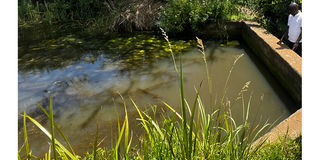Protecting Lake Magadi, Kenya’s main source of soda ash
Sponsored by Tata Chemicals Magadi Ltd

Lake Magadi.
Lake Magadi is a rain-fed water body located in a hot semi-arid area in the south-western part of Kenya. Besides rain, the lake is also fed by about 80 hot springs in and around it.
Lake Magadi is a source of the mineral trona, which is a precursor of soda ash.
Tata Chemicals Magadi Ltd (TCML), dredges this trona out and calcines it to make soda ash. About 90 percent of this soda ash is exported, and TCML is the leading foreign exchange earner on this for the country.
Lake Magadi is a very unique and fragile geological phenomenon, where the trona keeps regenerating over time. The trona regenerates to mine-able thickness after every 10 to 15 years.
Various geological studies have been done around Lake Magadi to understand this process. It has been concluded that there are faults around Lake Magadi, which lie within the mining area (see Fig 1).
Rain water seeps through these faults to deep underground and gets heated by the tectonic activities. This heated water dissolves various sodium salts that are present in the strata, and goes to the lake through the aforementioned hot springs (see Fig 2).
The hot spring liquor evaporates due to the high heat and low humidity around Magadi, leaving trona behind.
TCML has been very meticulous in maintaining the mining area, where the faults exist, so that trona regenerates in perpetuity. The community around Lake Magadi has also been very instrumental in maintaining the mining area to its pristine form.

Loita Springs.
Serious ecological threat
Lake Magadi has been under serious ecological threat during the last decade due to siltation. The major cause of siltation is environmental degradation in the upper and middle catchment areas due to deforestation and cultivation. Other contributing factors are infrastructure development – the Mai Mahiu/Narok road and the Standard Gauge Railway (SGR) phase two. It was resulting in the deposition of 8000 tons of silt with each flooding.
TCML has spent over Ksh400 million managing the siltation challenge in the last nine years. Among the initiatives include rain water diversion, desilting of water pans, building of dykes, excavating and skirting away of deposited silt (Photo 1 below), and construction of gabions on the Northern part of the Lake Magadi basin (Photo 2 below). This has been with the assistance of the Mosiro community, NEMA, and WARMA.

Photo 1: Excavation of silt at the Lake Magadi Northern basin.

Photo 2: Gabions built across the lake basin in dyke form to stop silt from depositing into Lake Magadi at the Northern end.


